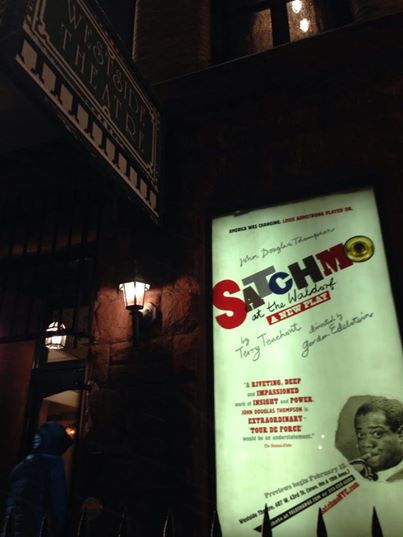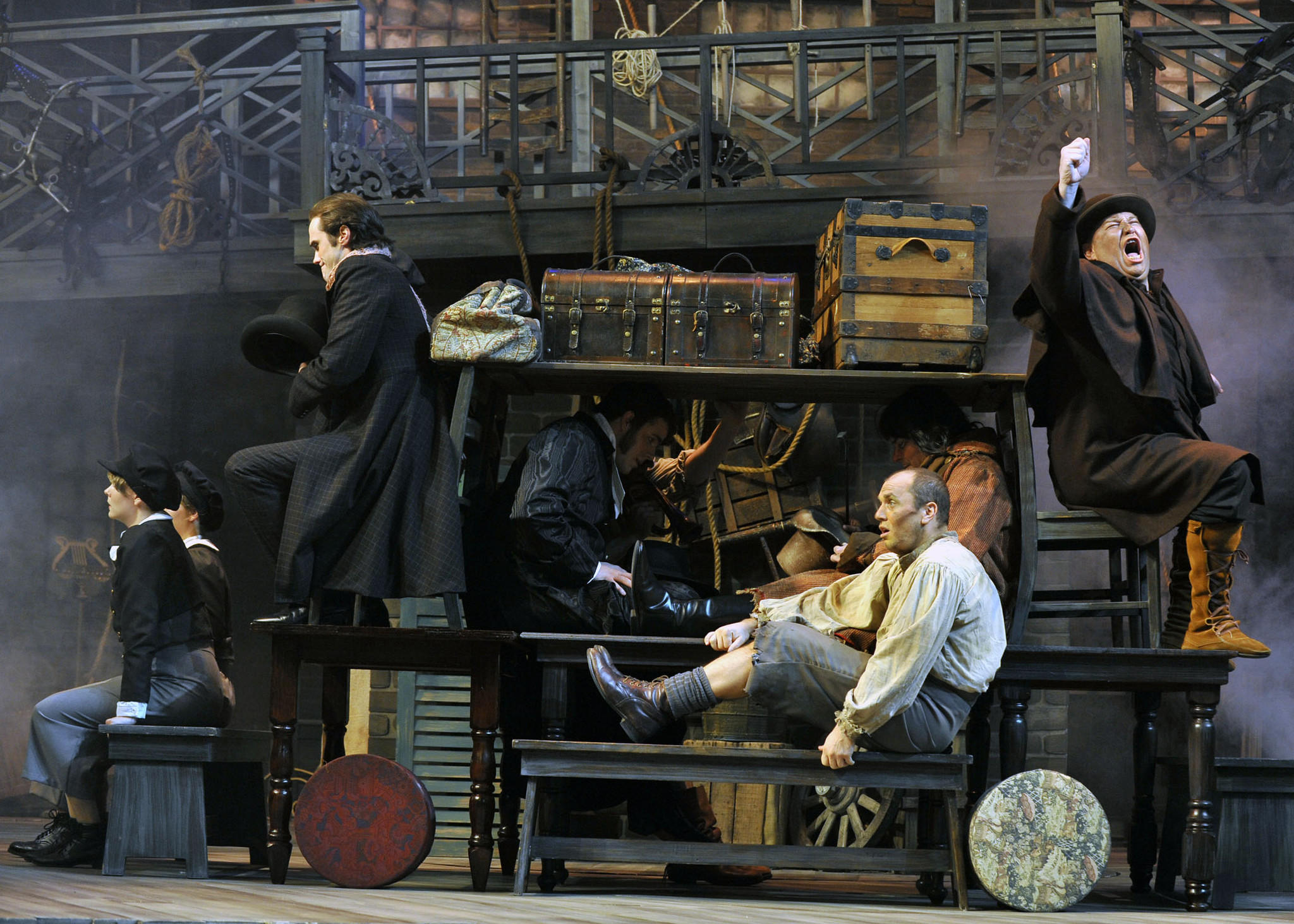 The first two preview performances of the off-Broadway transfer of Satchmo at the Waldorf took place on Saturday night and Sunday afternoon at the Westside Theatre, and they both went well–very well, if I do say so myself. John Douglas Thompson got well-deserved standing ovations both times, and I came home on Sunday feeling a lot better than I did on Friday, when I flew up to New York from Orlando with snow on my heels, a show coming into town, and (as if life hadn’t already been sufficiently complicated) a crippled laptop in my shoulder bag.
The first two preview performances of the off-Broadway transfer of Satchmo at the Waldorf took place on Saturday night and Sunday afternoon at the Westside Theatre, and they both went well–very well, if I do say so myself. John Douglas Thompson got well-deserved standing ovations both times, and I came home on Sunday feeling a lot better than I did on Friday, when I flew up to New York from Orlando with snow on my heels, a show coming into town, and (as if life hadn’t already been sufficiently complicated) a crippled laptop in my shoulder bag.
What next? I went to bed on Sunday and slept for twelve straight hours. Having done so, my plan for the rest of Monday is to listen to relaxing music, read an improving book, and think about nothing in particular. No deadline this afternoon, no show tonight. Life begins anew on Tuesday, but today I need a rest, and I plan to get one. See you tomorrow.
Oh, yes–if you haven’t already bought tickets to see Satchmo, what’s keeping you? Time’s a-wasting! Go here and do so forthwith. You’ll be glad you did.
Just because: Sid Caesar in Little Me
Courtesy of Will Friedwald, Sid Caesar performs a scene from Little Me, the Neil Simon-Carolyn Leigh-Cy Coleman musical version of Patrick Dennis’ novel, on The Ed Sullivan Show in 1963. The choreography is by Bob Fosse:
(This is the latest in a series of arts-related videos that appear in this space each Monday and Wednesday.)
Almanac: Mark Twain on laughter
“Power, Money, Persuasion, Supplication, Persecution–these can lift at a colossal humbug,–push it a little–crowd it a little–weaken it a little, century by century: but only Laughter can blow it to rags and atoms at a blast. Against the assault of Laughter nothing can stand.”
Mark Twain, “Chronicle of Young Satan” (courtesy of Tim Hulsey)
Out of the depths
In today’s Wall Street Journal I review a rare American revival by Orlando Shakespeare Theater of The Life and Adventures of Nicholas Nickleby. Here’s an excerpt.
* * *
Before “Angels in America,” there was “The Life and Adventures of Nicholas Nickleby.” The Royal Shakespeare Company’s eight-and-a-half-hour-long stage version of Charles Dickens’ 1839 novel, directed by Trevor Nunn and John Caird, transferred to Broadway from London’s West End in 1981, snapped up a best-play Tony and created in a single stroke the modern vogue for the marathon multi-part shows that have come to be known as “event theater.”
 Not surprisingly, revivals of “Nicholas Nickleby,” which calls for 39 actors, are rare. Accordingly, David Edgar, who wrote the script, prepared an abridged version in 2006 that has since been mounted three times on this side of the Atlantic. Now Orlando Shakespeare Theater has taken it on, with results that are both spectacular and satisfying. I didn’t see the original production, which by all accounts was a miracle of creative stagecraft, but it’s hard to imagine that it was more moving–or fun–than Orlando Shakespeare’s six-and-a-half-hour version, directed by Jim Helsinger and Christopher Niess, whose 27 actors (who play 150-odd characters) are deployed with infinite resourcefulness….
Not surprisingly, revivals of “Nicholas Nickleby,” which calls for 39 actors, are rare. Accordingly, David Edgar, who wrote the script, prepared an abridged version in 2006 that has since been mounted three times on this side of the Atlantic. Now Orlando Shakespeare Theater has taken it on, with results that are both spectacular and satisfying. I didn’t see the original production, which by all accounts was a miracle of creative stagecraft, but it’s hard to imagine that it was more moving–or fun–than Orlando Shakespeare’s six-and-a-half-hour version, directed by Jim Helsinger and Christopher Niess, whose 27 actors (who play 150-odd characters) are deployed with infinite resourcefulness….
For Dickens, characterization was caricature: Nicholas is the Good Guy, Ralph the Bad Guy, and everybody else is an elaborately drawn cartoon. That’s what makes his novels so hard for many contemporary readers to get through–and what makes them so effective when adapted for the stage or the screen. Instead of wading through page-long thickets of broad-brush description, you watch talented actors portraying the characters, which frees you to focus on the plot and dialogue.
That’s where Orlando Shakespeare’s “Nicholas Nickleby” shines most brightly: The cast is consistently superior, starting with Greg Thornton, who plays Ralph as a hawk-faced, flint-hearted monster of self-will who, like Ebenezer Scrooge, has renounced human kindness. “All love is cant and vanity,” he rasps, and you know at once that the fires of hell await him. What is most impressive about Mr. Thornton’s performance, though, is that it isn’t a caricature: You believe in its reality, which makes Ralph’s decision to live without love even more horrifying….
* * *
Read the whole thing here.
The opening scene of the original Royal Shakespeare Company production of Nicholas Nickleby, telecast in 1983:
More than a rag
In today’s Wall Street Journal “Sightings” column, I look at the developing controversy over the possible removal of a painting by Pablo Picasso from a famous New York skyscraper. Here’s an excerpt.
* * *
Pablo Picasso’s most readily accessible painting isn’t in a museum. It hangs in a New York restaurant–a restaurant that is housed in a building whose owner reportedly thinks that the painting is a piece of junk and wants to get rid of it.
 “Le Tricorne” is a 19-foot-high canvas that Picasso painted in 1919 for Sergei Diaghilev’s Ballets Russes. It was originally used as a curtain for “The Three-Cornered Hat,” a now-classic ballet composed by Manuel de Falla and choreographed by Léonide Massine for which Picasso designed the sets and costumes. John Richardson, Picasso’s biographer, considers the décor for the ballet to be his “supreme theatrical achievement,” and the curtain is a priceless relic, one of the last surviving souvenirs of the most influential ballet company of the 20th century. Forty years after Picasso painted it, Philip Johnson incorporated “Le Tricorne” into his plans for the Four Seasons Restaurant, which is located in Mies van der Rohe’s Seagram Building, a 38-story skyscraper that is itself a classic of modern architecture. Ever since the Four Seasons opened in 1959, “Le Tricorne” has hung in the entryway, where it can be seen not only by patrons but by passers-by. The interior of the Four Seasons was designated as a landmark in 1989, meaning that it can’t be altered without official approval.
“Le Tricorne” is a 19-foot-high canvas that Picasso painted in 1919 for Sergei Diaghilev’s Ballets Russes. It was originally used as a curtain for “The Three-Cornered Hat,” a now-classic ballet composed by Manuel de Falla and choreographed by Léonide Massine for which Picasso designed the sets and costumes. John Richardson, Picasso’s biographer, considers the décor for the ballet to be his “supreme theatrical achievement,” and the curtain is a priceless relic, one of the last surviving souvenirs of the most influential ballet company of the 20th century. Forty years after Picasso painted it, Philip Johnson incorporated “Le Tricorne” into his plans for the Four Seasons Restaurant, which is located in Mies van der Rohe’s Seagram Building, a 38-story skyscraper that is itself a classic of modern architecture. Ever since the Four Seasons opened in 1959, “Le Tricorne” has hung in the entryway, where it can be seen not only by patrons but by passers-by. The interior of the Four Seasons was designated as a landmark in 1989, meaning that it can’t be altered without official approval.
End of story…right? Not even close.
Because “Le Tricorne” is a painting, it’s not a physical part of the Seagram Building. So even though it’s now owned by the New York City Landmarks Conservancy, it’s not covered by the landmark designation–and Aby Rosen, a real-estate developer whose company, RFR Holding, owns the building, wants to move it. RFR is claiming that the wall on which “Le Tricorne” was hung by Johnson is in imminent danger of collapse and needs to be rebuilt. The Museum of Modern Art has offered to store “Le Tricorne” but not to display it, and art conservators believe that the painting, which is brittle, can’t be moved without destroying it.
According to the New York Times, Mr. Rosen, an art collector who goes in for avant-garde work, doesn’t like “Le Tricorne” and would prefer to hang pieces from his own collection in the space that it currently occupies. One person actually claims to have heard him dismiss the painting as a “schmatte,” which is Yiddish for “rag.” And since Mr. Rosen owns the Seagram Building, he’s legally entitled to demand that the Landmarks Commission remove “Le Tricorne,” even if it fails to survive….
Mr. Rosen claims to appreciate art. Well, here’s the acid test of his appreciation. Is it really so important for him to hang his Damien Hirst and Jeff Koons pieces in a space that was custom-tailored by Philip Johnson to show off a treasure of modernism like “Le Tricorne”? Now’s his chance to show that he truly cares about great art….
* * *
Read the whole thing here.
Almanac: Anthony Powell on facing facts
“There was nothing like facing facts. They blew into the face hard, like a stiff, exhilarating, decidedly gritty breeze, which brought sanity with it, even though sanity might be unwelcome.”
Anthony Powell, The Kindly Ones
So you want to see a show?
Here’s my list of recommended Broadway, off-Broadway, and out-of-town shows, updated weekly. In all cases, I gave these shows favorable reviews (if sometimes qualifiedly so) in The Wall Street Journal when they opened. For more information, click on the title.
BROADWAY:
• A Gentleman’s Guide to Love & Murder (musical, PG-13, reviewed here)
• Matilda (musical, G, most performances sold out last week, reviewed here)
• No Man’s Land/Waiting for Godot (drama, PG-13, playing in rotating repertory, closes Mar. 30, reviewed here)
• Once (musical, G/PG-13, reviewed here)
• Outside Mullingar (comedy, PG-13, closes Mar. 16, reviewed here)
OFF BROADWAY:
• Avenue Q (musical, R, adult subject matter and one show-stopping scene of puppet-on-puppet sex, reviewed here)
• The Fantasticks (musical, G, suitable for children capable of enjoying a love story, reviewed here)
CLOSING SOON OFF BROADWAY:
• Hamlet/Saint Joan (drama, G/PG-13, remounting of off-Broadway production, playing in rotating repertory, closes Mar. 9, original production reviewed here)
CLOSING SOON IN GLENCOE, ILL.:
• Port Authority (drama, PG-13, closes Mar. 2, reviewed here)
CLOSING SOON IN WEST PALM BEACH, FLA.:
• Old Times (drama, PG-13, closes Mar. 2, reviewed here)
CLOSING SUNDAY ON BROADWAY:
• Twelfth Night (Shakespeare, G/PG-13, all performances sold out last week, reviewed here)
Almanac: Anthony Powell on love
“In real life, things are much worse than as represented in books. In books, you love someobdy and want them, win them or lose them. In real life, so often, you love them and don’t want them, or want them and don’t love them.”
Anthony Powell, The Kindly Ones
